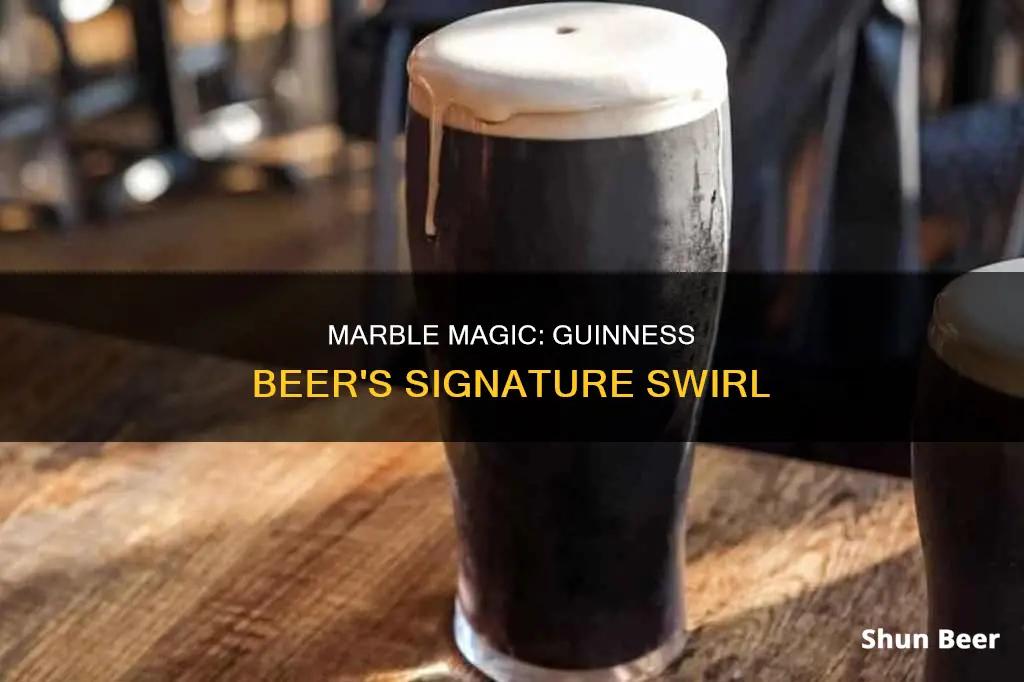
If you've ever opened a can of Guinness, you may have noticed a small plastic ball floating inside. This is called a widget, and it's there to give your beer that signature creamy, velvety head. Guinness developed the widget in 1969 to replicate the draught experience in a can. During the canning process, brewers add liquid nitrogen, which quickly evaporates and creates pressure inside the can. When you open the can, the pressure is released, and the nitrogenated beer escapes from the widget, mixing with the rest of the beer and creating a burst of tiny bubbles that give Guinness its distinctive thick, creamy head.
| Characteristics | Values |
|---|---|
| Name | Widget |
| Material | Plastic |
| Shape | Spherical |
| Size | Similar to a ping pong ball |
| Colour | White |
| Function | Releases nitrogen into the beer |
| Result | Thick, creamy head |
| Inventor | Guinness |
| Inventor (individual) | Tony Carey and Sammy Hildebrand |
| Year of invention | 1969 |
| Year of release | 1989 |
What You'll Learn

The marble is called a widget
The marble in Guinness beer is called a widget. It is a small, hollow, spherical piece of food-grade plastic with a tiny hole in it, resembling a ping pong ball. During the canning process, brewers add liquid nitrogen to the beer before sealing the can. The liquid nitrogen quickly evaporates, creating pressure inside the can, which forces gas and liquid into the widget. When the can is opened, the pressure inside drops to equalize with the room's pressure, but the pressure inside the widget remains higher, causing the nitrogenated beer to squirt into the rest of the beer. This creates a burst of tiny nitrogen bubbles that rise to the top of the beer, forming a thick, creamy head similar to a freshly poured pint of Guinness.
Guinness first patented the widget idea in 1969, aiming to replicate the draught experience and give their canned beers a silky, creamy head. However, it wasn't until 1989 that they released their first-generation widget, a flattened disc at the bottom of the can. While it worked well with cold beer, it caused overflow issues when the beer was warm. To address this problem, Guinness introduced the floating, spherical widget in 1997, known as the "Smoothifier."
The widget has been praised as a significant innovation, even being voted as a greater invention than the internet by nearly 9,000 people in a 2004 survey. It ensures that Guinness drinkers can enjoy a perfectly smooth and creamy beer, whether from a can or a bottle.
The widget technology has since been adopted by other beer brands, and it has become a popular feature in canned and bottled beers, enhancing the drinking experience for consumers worldwide.
Guinness Beer: Healthy Choice or Dark Deception?
You may want to see also

It was developed in 1969
The plastic widget, or marble, found in Guinness beer cans was developed in 1969 to give their canned brews a silky, creamy head. Guinness brewers first patented the idea of the widget in 1969, but it wasn't until two decades later in 1989 that they released their first-generation widget. This was a flattened sphere that sat at the bottom of the can. While it worked well when the beer was served cold, it overflowed when served warm. In 1997, Guinness released the floating, spherical widget seen in cans today, which they call the "Smoothifier".
The widget is a tiny, hollow, spherical piece of food-grade plastic with a tiny hole in it, similar in appearance to a ping pong ball. During the canning process, brewers add liquid nitrogen to the beer immediately before sealing it. The liquid nitrogen quickly evaporates, but since the can is sealed, this creates pressure inside, which forces gas and liquid into the widget through its tiny hole. When the can is opened, the pressure drops, and the nitrogenated beer inside the widget is released into the rest of the beer, creating a foamy head.
Guinness's dedication to innovation dates back to Arthur Guinness, who in 1801 created the brand's first major innovation, West India Porter. He found a way to export his beer to countries like the West Indies by creating a recipe with a high alcohol and hops content, resulting in a more intense beer that could preserve itself for long journeys overseas.
In 1951, mathematician and master brewer Michael Ash joined the Guinness team. Ash became fascinated by the idea of serving Guinness in draught format and was convinced that adding nitrogen to the beer was the most effective way to do this. Ash’s ‘Easy Serve’ system created the ‘surge and settle’ effect that draught Guinness is now famous for, and Guinness became the world's first nitro beer.
Guinness Beer: Extra Stout or Draught, What's Original?
You may want to see also

It was patented in 1989
Guinness beer has long been associated with innovation, dating back to its founder, Arthur Guinness, who in 1801 created a high-alcohol, hoppy beer that could preserve itself for long journeys to export markets like the West Indies. This dedication to innovation has persisted as a key part of the brand's mission.
One notable example of Guinness' innovation is the development of the "widget", a small plastic ball inserted into cans of Guinness beer. The widget was designed to give canned Guinness the same silky, creamy head that characterises the draught beer served in pubs. This was achieved through nitrogenation, which involves infusing the beer with nitrogen gas to create a smoother and more delicate taste compared to carbonation with carbon dioxide.
The widget technology was first patented by Guinness in 1969, but it wasn't until two decades later, in 1989, that they released their first-generation widget. This initial version was a flattened disc that sat at the bottom of the can. It performed well when the beer was served cold, but if the beer was warm, it could cause overflow when the can was opened.
The release of the first-generation widget in 1989 marked a significant milestone in Guinness' quest to bring the draught experience to canned beer. It represented the culmination of years of research and development, overcoming various technical challenges along the way. This first iteration laid the foundation for subsequent improvements, demonstrating Guinness' unwavering commitment to innovation and enhancing the drinking experience for its customers.
In 1997, Guinness introduced the second iteration of the widget, known as the "Smoothifier". This version addressed the issue of overflow by adopting a floating, spherical design. The Smoothifier continues to be used in cans of Guinness today, ensuring that each pour delivers the distinctive thick, creamy head that has become synonymous with the brand.
Guinness: Beer or Lager? Understanding the Dark Irish Drink
You may want to see also

It's used to create a creamy head
The marble in a can of Guinness is a small, hollow, spherical piece of food-grade plastic with a tiny hole in it, commonly known as a widget. During the canning process, brewers add liquid nitrogen to the beer, which quickly evaporates, creating pressure inside the can. This pressure forces gas and liquid into the widget. When the can is opened, the pressure inside drops to equalise with the room, but the pressure inside the widget remains higher. This causes the nitrogenated beer inside the widget to squirt into the rest of the beer, creating a burst of tiny bubbles that rise to the top of the liquid, forming a creamy head.
The widget was developed by Guinness in 1969 to give their canned beers a silky, creamy head, similar to a freshly poured draught beer. Guinness brewers Tony Carey and Sammy Hildebrand patented the widget in British Patent No 1266351, filed in 1969, with a complete specification published in 1972. However, it wasn't until 1989 that they released their first-generation widget, a flattened disc that sat at the bottom of the can. While this widget worked well with cold beer, it caused the beer to overflow when served warm. To address this issue, Guinness introduced the floating, spherical widget in 1997, known as the "Smoothifier".
The widget is designed to replicate the draught experience in a can. When a can of Guinness is opened, the widget releases a surge of bubbles, creating a thick, creamy head similar to that of a freshly poured pint. This innovation ensures that each can of Guinness delivers a perfectly smooth and velvety drinking experience, true to the unique characteristics of the beer.
The use of nitrogenation is key to achieving the rich and creamy texture associated with Guinness. While carbon dioxide is commonly used to give beer its bitter fizz, Guinness infuses its ale with nitrogen to create a smoother and more delicate taste. Nitrogen bubbles are smaller than carbon dioxide bubbles, resulting in a smoother head and mouthfeel. Additionally, nitrogen gas has a lower solubility in water, allowing more gas to be released upon opening the can, which contributes to the formation of a thicker, creamier head.
The widget in a can of Guinness is a clever innovation that ensures a consistent and distinctive drinking experience. By releasing nitrogen into the beer, it creates a creamy head that is synonymous with the brand, enhancing the overall sensory experience of enjoying a Guinness.
Guinness Beer Preservatives in NY: What's the Deal?
You may want to see also

It replicates the draught experience
The marble in a can of Guinness beer is called a widget. It is a small, hollow, spherical piece of food-grade plastic with a tiny hole in it. During the canning process, brewers add liquid nitrogen to the beer immediately before sealing it. The liquid nitrogen quickly evaporates, creating pressure inside the can. When the can is opened, the gas and liquid leave the widget, creating a foamy head and giving the beer a velvety texture. This "surge and settle" effect replicates the draught experience, as if the beer was just poured fresh from the tap.
The widget was developed by Guinness in 1969 to give their canned brews a silky, creamy head. The first-generation widget was released in 1989 and was a flattened disc that sat at the bottom of the can. However, it had issues with overflowing when the beer was warm. In 1997, Guinness released the floating, spherical widget that is still used today.
The widget has been praised as one of the greatest inventions of the 20th century, with some even claiming it to be a greater invention than the internet. In a 2004 survey of almost 9,000 people, the widget was voted as a more significant invention than the internet.
The use of nitrogen in beer is a key innovation of Guinness. Nitrogen bubbles are smaller than carbon dioxide bubbles, resulting in a smoother and more delicate head and taste. This also gives the beer a thicker and more velvety "mouthfeel" without the acidic bite of carbonation.
Guinness Beer: A Protein-Rich Brew?
You may want to see also
Frequently asked questions
There isn't a marble in Guinness beer. However, there is a small plastic ball, which is called a widget.
The widget is a hollow, spherical piece of food-grade plastic with a tiny hole in it. It releases nitrogen into the beer to give it a smooth, creamy head.
Guinness is a nitrogenated beer. Nitrogen bubbles are smaller than carbon dioxide bubbles, so the resulting head and taste are smoother and more delicate. However, it is hard to maintain tasty levels of nitrogen in packaged beers once they are opened, so the widget slowly releases nitrogen into the beer when the can is opened.
The widget gives Guinness beer a smooth, velvety texture and a thick, creamy head, similar to a freshly poured draught Guinness.







